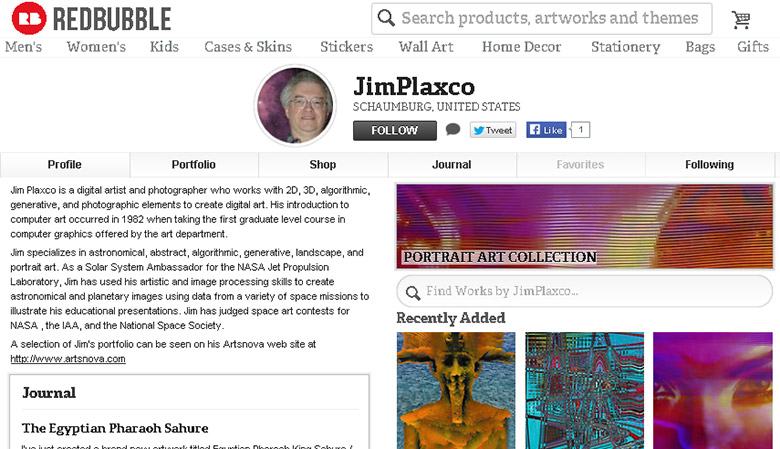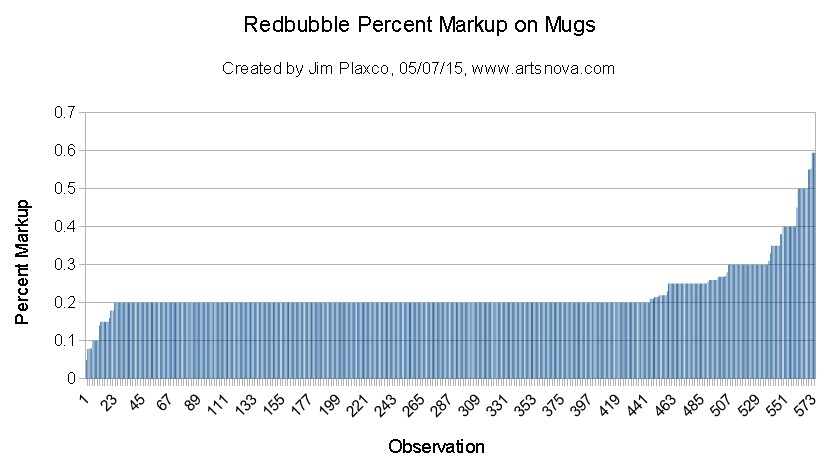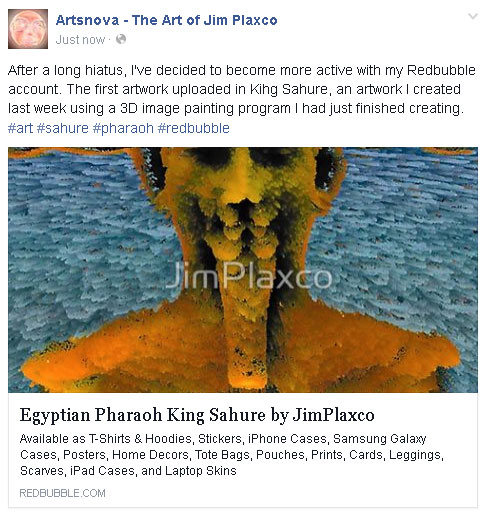Selling Art On Redbubble - A Review

Jim Plaxco's Redbubble Profile Page
By Jim Plaxco, 05/12/2015
Quite some time ago I created an account on Redbubble.com but have never fully used it. For those who aren't familiar with it, Redbubble is a print-on-demand service that sells art prints and products on which art has been printed. The providers of this art are the artists who have signed up with Redbubble. For my part, prior to this article I had only uploaded ten artworks and had only made them available as art prints - ignoring the various other product options.
Frankly, I create accounts on many platforms so that I can investigate how they work and how they compare with their competitors. This is of particular interest to me given my long history of professional interest in the Internet, evolving standards, and user design. This interest is also driven by the fact that I lecture on certain aspects of using the Internet for business as well as having provided pro-bono consulting services to several non-profit organizations.
As a part of writing this review, I decided to add a new artwork to my account so that I could more accurately conduct my review. As a platform for artists seeking to monetize their art, Redbubble has a number of things going for it. Broadly speaking, the attributes of all such print-on-demand platforms can be categorized as features, interface design, products, and pricing.
Features of Redbubble
As an artist, the features of Redbubble that are most useful and which I will address individually are:
- Art and Product Workflow
- Product Variety
- Pricing Flexibility
- Journal
- Collections
- Art Tags
- Groups
- Social Sharing
- Google Analytics
Redbubble Art and Product Workflow
I consider the workflow associated with adding new art and products, as well as editing existing art and products, to be an important platform feature that falls under the heading of usability. While I have found that some platforms make it difficult to add and edit artwork and products (less usable), I find Redbubble's workflow to be streamlined and simple (more usable). As an artist and designer, I appreciate the way in which Redbubble has designed their system for both adding new art/products and editing existing art/products. Simple, flexible, and intuitive are important usability features for me.
Redbubble Product Variety
Redbubble offers a variety of product options for artists and all it takes is the click of a button to add a product offering for uploaded artwork. There is of course the standard fare of posters, photographic prints, art prints, framed prints, canvas prints, and metal prints. Redbubble also offers a range of other product options. These options include cards, smartphone and tablet cases and skins, mugs, pillows, scarves, and tees, etc. The availability of multiple products provides the artist with more ways in which to monetize and market their art.
One thing all these products have in common is that they each have a different form factor (size and aspect ratio). I have worked with other platforms that require artists to upload tailor-made images that are specific to each individual product - a task that can be quite tedious. With Redbubble I can resize and reposition a single image for all products. Alternatively, for any product(s) for which I can not achieve the effect I want, I have the option to upload a custom image just for that product.
Redbubble Pricing Flexibility
Product pricing on Redbubble is clear and unambiguous. The base cost of all products is provided and artists are free to specify their desired markup in one of three ways. First an artist can specify a percentage markup that will be applied to all products. Second an artist can specify percentage markups that are specific to categories of products. Lastly artists can specify an individual markup by artwork and product. I have not encountered a system more flexible than this.
As to pricing, there are two challenges that face the artist. The first challenge is that of the base price of a product. In other words, how does the base price of a 16x20 print or a mug or an iPhone case on Redbubble.com compare with similar products being offered by competing services? For example, let's pretend that the base price for a 16x20 art print on Redbubble is $40.00 and you as an artist add a markup of 20%. That means the final selling price will be $48.00. Alternatively let's suppose that a competing POD (print-on-demand) service (examples being Zazzle, Cafepress, Imagekind, Artflakes,etc.) has a base price of $20.00 for their 16x20 art print. In order to make your $8 commission on this other platform you would need to specify a markup of 40% resulting in a selling price of $28.00. Assuming no qualitative differences, a smart buyer would opt to purchase from the platform whose price is $28.00 rather than $48.00. I hope that this fictious example clearly illustrates the principle of product cost and price differential between the various online services.
The second challenge an artist faces is how to markup a product versus the markup being applied by the other Redbubble artists to the same product. Redbubble sets as a default value an artist markup of 20%. Every artist is free to change this as they see fit. For example you may want to apply a markup of 100%. But now consider the issue from the buyer's perspective.

Redbubble Mug Distribution of Artist Markup Percentages Data
I will use a uniform product like mugs to illustrate the principle. The base price for mugs on Redbubble is currently $12.50. The default 20% markup results in a selling price of $15.00. When I, as a buyer, go to the mugs product page I am confronted with an overwhelming number of mugs priced at $15.00 (courtesy of the default 20% markup). A mug marked up 100% by an artist is going to be selling for $30.00. What do you think your chances are of selling a mug at $30 when the overwhelming majority of mugs are selling at $15.00? I did a random sampling of 575 mugs and found that the average selling price was $15.31. An analysis of the individual markups shows that the average artist markup is just 22%. The results of this analysis are shown in Figure A. As you can clearly see most mugs are priced at the default 20% markup - making it difficult for artists who want a higher profit margin to be cost competitive. As an artist, I would of course prefer that the default markup applied by Redbubble was more than 20 percent.
Redbubble Journal
One feature of Redbubble that I have underutilized and which falls into the category of marketing, is its Journal feature - which can be thought of most simply as a blog. The Journal allows artists to create additional content about themselves, their art, and their activities.
Redbubble Collections
The Collections feature allows an artist to create groups of art. For example, an artist specializing in portraits could create collections based on male portraits, female portraits, child portraits, black and white portraits, etc. For my part the only collection I have created so far is a collection for portraits.
Redbubble Art Tags
Redbubble provides a tagging feature so that keywords can be associated with the artwork that has been uploaded. Redbubble allows artists to add up to 50 keywords per artwork. Redbubble is trusting the artists to use this feature honestly and intelligently in order to help buyers find just what they are looking for.
Redbubble Groups
Redbubble has a very large number of art groups in which artists can post and promote their artwork, as well as commenting on the art of others. Artists wanting to promote their work in these groups should make sure that they adhere to the group's rules as established by the group's volunteer administrator.
Redbubble Social Sharing

What A Redbubble Share on my Artsnova Art Gallery Facebook Page looks like
Once artwork has been uploaded and associated with products, Redbubble provides a widget for social sharing with Twitter, Facebook, Tumblr, Google+, and Pinterest. I hope that at some time Redbubble adds a widget to facilitate promotion on the artist's own web site and/or blog.
Redbubble Google Analytics
Redbubble provides the capability to add a Google Analytics tracking code to an artist's pages on Redbubble. If you have a web site, chances are that you already have a Google Analytics account and are using it to measure your site's traffic. Why not measure the traffic to your Redbubble pages while you're at?
Review Summary
From an artist/user perspective, I find Redbubble to be a well-designed, easy-to-use platform with a nice variety of products.
My main criticism is that Redbubble is not mobile-friendly. This is now more than ever before a problem given Google's April 2015 change to their algorithm for ranking web sites for search results. If your web site is not mobile-friendly, you will be penalized. This is why I converted my web site last year to be mobile friendly and also why I recently converted my blog to be mobile friendly - with both employing the responsive web design paradigm.
For those artists thinking about selling their art on Redbubble, I hope that you have found this review useful.
My Art on Redbubble
Following are links to the art that I currently have for sell on Redbubble.com
- Electronic Sound
- Egyptian Pharaoh King Sahure
- Up Close and Personal Female Portrait Art
- Portrait of a Polar Explorer
- Rock Pillar, Grand Canyon National Park, Arizona
- Liberty She Shouted
- Summer Day Forest Scene
- Generative Selfie Self-Portrait
- Metropolis Machina
- Lift Off - Space Launch
- A Mondrian Gone Bad
Related Reviews
If you found this review useful, you may also be interested in these POD (print on demand) site reviews: